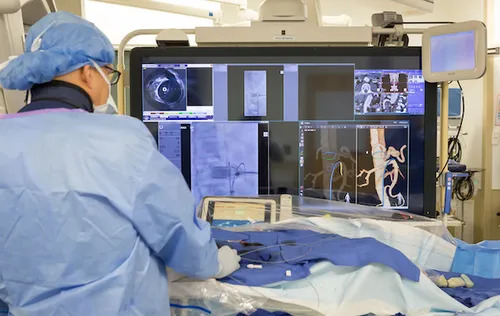One of the major advances in making complex aortic repairs safer was the advent of endovascular surgery – a minimally invasive approach that allows us to make essentially incisionless aortic repairs with less pain, lower risk of complications, and shorter recovery time.
While endovascular procedures such as transaortic valve repair (TAVR) or fenestrated endovascular aortic repair (FEVAR) are significantly more efficient than traditional open surgery, these procedures require us to take multiple intraoperative X-rays to guide our surgeons in the repair.
This process slows down the procedure, and with each X-ray, the patient and surgical team get radiation exposure. While the amount a patient gets from an X-ray is relatively low, at approximately 0.006% the amount of annual radiation exposure the average person gets living in the U.S., multiple exposures a day over several years can add up to health risks for the care team. But a novel imaging device – Fiber Optic RealShape (FORS) – is changing how we approach aortic repairs. UT Southwestern is one of five medical centers in the U.S. – and one of 10 in the world – chosen to participate in the early implementation of FORS due to our expertise and the high volume of complex aortic repairs we perform.
And the change has been truly illuminating.
The FORS device contains hair-thin optical fibers embedded in specially designed wires and catheters. When the device is guided through a blood vessel, the optical fibers bend, which changes the light’s pathway. A computer algorithm uses that information to create a 3D reconstruction of the blood vessel, which is paired with preoperative CT scan imaging to provide a roadmap that is rendered on a large screen to guide us during surgery.
Given 501(k) clearance by the U.S. Food and Drug Administration (FDA) for marketing, FORS swaps intraoperative X-rays for fiber optic lighting and 360-degree imaging from inside the blood vessels in real time.
While there may still be a need for an X-ray during the procedures, the technology allows us to greatly reduce radiation exposure while increasing surgical efficiency and precision.
Benefits of using FORS over X-rays

Conventional imaging such as X-ray shows us a two-dimensional image with one angle at a time. If we want a view from another angle, we have to change the position of the X-ray machine, slowing down the procedure. But with FORS, we can see 360 degrees within the blood vessel and the heart. The wire in the device has optical fibers all the way around it, shining light and visibility from every angle.
With a quicker procedure, the patient doesn’t have to be under anesthesia as long – another safety benefit.
The increased visualization is particularly helpful when patients have pins or plates, or they’re obese or overweight. While these factors complicate getting high-quality images from outside the body, viewing the blood vessels and heart from inside with FORS significantly improves visibility.
A bright future for FORS
Philips, the company that manufactures FORS, is designing new catheters and wires that will make the technology more widely applicable for other procedures.
As an early implementer of FORS, our heart and vascular surgeons can use the technology in endovascular procedures beyond aortic repairs when it can benefit patients. We have the support of UT Southwestern, both in our clinics and as an academic institution, to explore new possibilities with the goal of improving patient care.
So, when we get the opportunity to implement new technologies like FORS, we can support making leading-edge technology widely available – giving more patients the chance to benefit from safer, more precise heart and vascular surgery.
To find out whether you or a loved one might benefit from visiting with a vascular specialist, call 214-645-8300 or request an appointment online.









